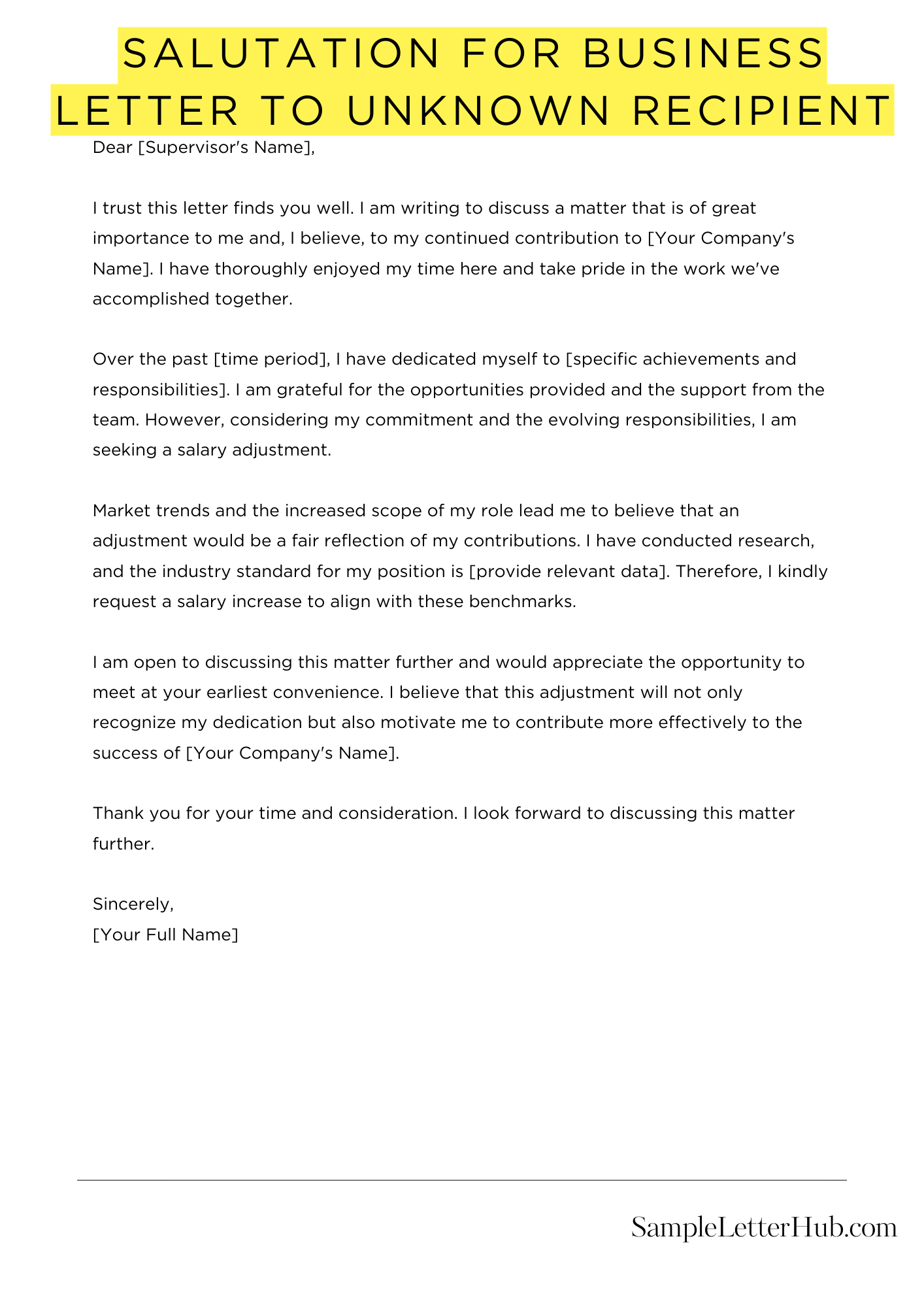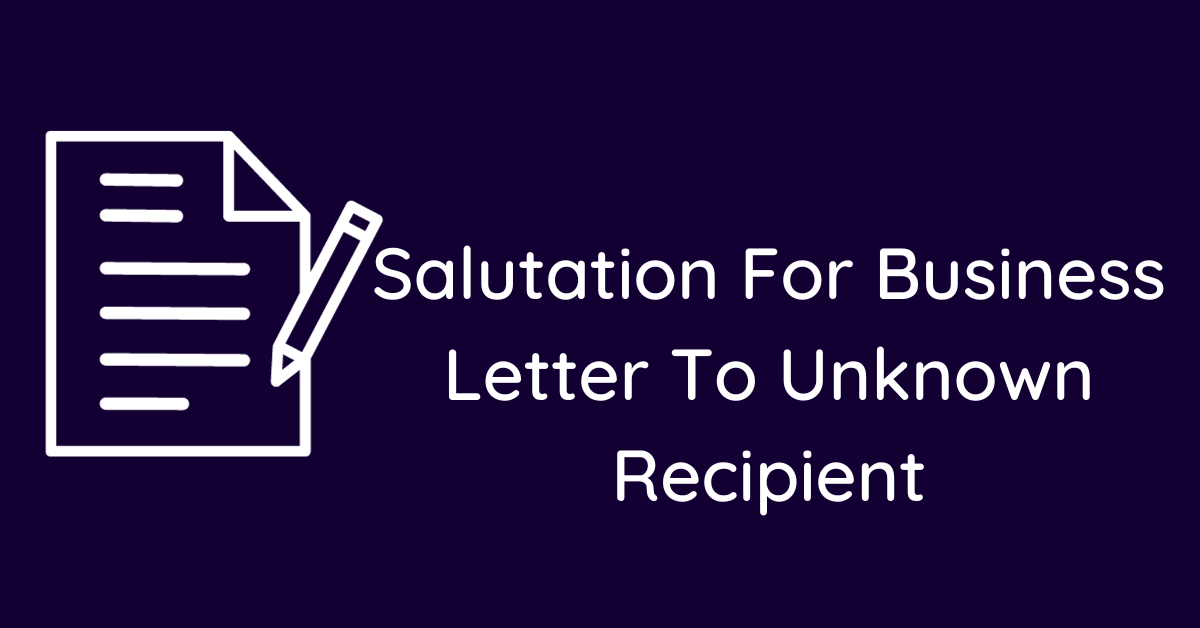Are you struggling to write a business letter to an unknown recipient? Don’t worry, you’re not alone. Many people find it challenging to address a letter when they don’t know the name of the person they’re writing to.
That’s where the salutation for business letter to unknown recipient comes in. It’s a way to address the letter in a professional and respectful manner, without knowing the recipient’s name.
In this article, we’ll provide you with templates, examples, and samples of salutations for business letters to unknown recipient. Our goal is to make it easy for you to write any letter, whether it’s a cover letter, a job application, or a business proposal.
We understand that writing a letter can be daunting, especially when you don’t know who you’re addressing it to. That’s why we’ve put together this guide to help you navigate this tricky situation.
By the end of this article, you’ll have a better understanding of how to address a business letter to an unknown recipient, and you’ll have access to a variety of templates and examples to help you get started.
Whether you’re a seasoned professional or a beginner, our guide will provide you with the tools you need to write a successful business letter. So, let’s get started!
Salutation For Business Letter To Unknown Recipient
To Whom It May Concern,
I trust this letter finds you well. In the absence of a specific recipient, I extend my greetings to the individual responsible for the relevant department or matter at hand.
We are reaching out to explore potential collaboration and discuss matters of mutual interest. Your attention to this correspondence is highly valued.
If you could kindly direct this letter to the appropriate party or department, we would be grateful. Furthermore, we welcome the opportunity for a future conversation to explore how our organizations can work together.
Thank you for your time and consideration.
Best regards,
[Your Full Name]
Salutation For Formal Letter
Dear [Recipient’s Title and Last Name],
I trust this letter finds you in good health and high spirits. It is with great respect and courtesy that I extend my greetings to you.
As we embark on this formal communication, I wish to convey my sincere appreciation for your time and attention to this matter. Your expertise and insights are highly regarded.
In closing, I look forward to the opportunity for collaboration and fruitful discussions. If there are any further details required or if you have questions, please do not hesitate to contact me.
Thank you for your consideration and cooperation.
Sincerely,
[Your Full Name]
Professional Salutations For Letters
Dear [Recipient’s Title and Last Name],
I hope this letter finds you in good health and high spirits. It is with great pleasure that I reach out to you regarding [specific purpose or topic].
Your expertise in [relevant field] is well-known and highly regarded. I believe your insights will contribute significantly to our ongoing efforts.
In conclusion, I look forward to the opportunity for collaboration and constructive discussions. If you require any further information or clarification, please do not hesitate to contact me.
Thank you for your time and consideration.
Sincerely,
[Your Full Name]
Address A Letter To A Business To Unknown Recipient
To Whom It May Concern,
I trust this letter reaches the appropriate department or individual at your esteemed organization. As the specific recipient is unknown, I extend my greetings to the team responsible for [specific matter or department].
We are reaching out to express our interest in potential collaboration and to discuss matters of mutual benefit. Your attention to this correspondence is highly appreciated.
If possible, kindly direct this letter to the relevant party. We look forward to the opportunity for further discussions on how our organizations can work together successfully.
Thank you for your time and consideration.
Best regards,
[Your Full Name]
Closing For Business Letter To Unknown Recipient
Thank you for taking the time to consider our correspondence. We appreciate your attention and look forward to the possibility of future engagement.
If you require any further information or if there is a specific department or individual we should direct this communication to, please do not hesitate to inform us.
We value the potential for collaboration and hope this letter sparks interest. We anticipate the opportunity to discuss matters in more detail.
Once again, thank you for your time and consideration. We look forward to the prospect of working together.
Best regards,
[Your Full Name]

How to Write {Salutation For Business Letter To Unknown Recipient}
When it comes to writing a business letter, one of the most challenging aspects can be addressing the recipient. If you don’t know the name of the person you’re writing to, it can be difficult to know how to begin your letter. However, there are a few strategies you can use to craft a professional and effective salutation for your business letter.
1. Use a Generic Salutation
One option is to use a generic salutation, such as “”To Whom It May Concern”” or “”Dear Sir or Madam.”” While these salutations may seem impersonal, they are widely accepted in business correspondence and can be a safe choice if you’re unsure of the recipient’s name or gender.
2. Do Some Research
If possible, try to do some research to find out the name of the person you’re writing to. Check the company’s website, LinkedIn, or other professional networking sites to see if you can find the name of the recipient. If you’re still unsure, you can always call the company and ask for the name of the person who handles the type of issue you’re writing about.
3. Use a Job Title
If you know the recipient’s job title but not their name, you can use that information to craft a more personalized salutation. For example, you might write “”Dear Marketing Manager”” or “”Dear Human Resources Director.”” This approach shows that you’ve done some research and are addressing the letter to the appropriate person.
4. Address the Department
If you’re still unsure of the recipient’s name or job title, you can address the letter to the department instead. For example, you might write “”Dear Customer Service Team”” or “”Dear Accounting Department.”” This approach is less personal than addressing an individual, but it still shows that you’ve put some thought into your salutation.
5. Use a Gender-Neutral Salutation
If you’re unsure of the recipient’s gender, you can use a gender-neutral salutation such as “”Dear Colleague”” or “”Dear Friend.”” This approach is inclusive and respectful, and it can be a good choice if you’re writing to someone whose gender you don’t know.
FAQs About Salutation For Business Letter To Unknown Recipient
1. What is the best salutation to use when addressing an unknown recipient in a business letter?
– The best salutation to use when addressing an unknown recipient in a business letter is “”Dear Sir or Madam”” or “”To Whom It May Concern.”” These salutations are gender-neutral and appropriate for formal business correspondence.
2. Is it appropriate to use “”Dear Sir”” when addressing an unknown recipient in a business letter?
– While “”Dear Sir”” is a common salutation, it is not appropriate to use when addressing an unknown recipient in a business letter. This is because it assumes that the recipient is male, which may not be the case.
3. Can I use “”Dear Sir/Madam”” in an email?
– Yes, “”Dear Sir/Madam”” is an appropriate salutation to use in an email when addressing an unknown recipient. However, it is important to keep in mind that email is generally less formal than a traditional business letter.
4. What if I know the recipient’s job title but not their name?
– If you know the recipient’s job title but not their name, you can use a salutation such as “”Dear Marketing Manager”” or “”Dear Human Resources Director.”” This shows that you have taken the time to research the recipient’s position and are addressing them appropriately.
5. Should I use a comma after the salutation in a business letter?
– Yes, it is standard practice to use a comma after the salutation in a business letter. For example, “”Dear Sir or Madam,”” or “”To Whom It May Concern,”” followed by a comma.
6. Can I use “”Hello”” or “”Hi”” in a business letter?
– While “”Hello”” or “”Hi”” may be appropriate in a more casual setting, it is not recommended to use these salutations in a business letter. Stick to more formal salutations such as “”Dear Sir or Madam”” or “”To Whom It May Concern.”
Related:
- Physician Retirement Letter To Patients ( 5 Samples )
- Property Management Letter To Owners ( 5 Samples )
- Change Of Ownership Letter To Vendors ( 5 Samples)
- Letter To Extend Maternity Leave ( 5 Samples)
- Authorization Letter For Minor To Travel Without Parents (5 Samples)

